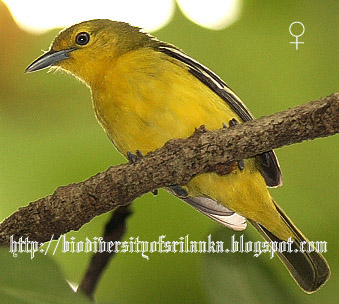Pages
- Home
- Flora of Sri Lanka
- Dragonflies & Damselflies of Sri Lanka
- Butterflies of Sri Lanka
- Freshwater Fishes of of Sri Lanka
- Amphibians of Sri Lanka
- Snakes of Sri Lanka
- Tetrapod Reptiles of Sri Lanka
- Mammals of Sri Lanka
- Resident Birds of Sri Lanka
- Migrant Birds of Sri Lanka
- Vagrant Birds of Sri Lanka
- Status Uncertain or Doubtful Birds of Sri Lanka
Tuesday, February 28, 2012
Sunday, February 26, 2012
Friday, February 24, 2012
Hill Swallow/කඳු වැහිළිහිණියා/හෙල් වැහිළිහිණියා[Kandu Wehilihiniya/Hel Wehilihiniya] (Hirundo domicola)
Hill swallow is a common breeding resident found in grass lands, plantations and open areas in villages and towns of the hill
country while occasional visitor to the foot hills of the wet zone. Its food
consist of small flying insects capturing on the wing, usually as small flocks
of its own members or others of the family like red-rumped swallow, Barnswallow.etc.The breeding season is from February to May and again in September.
It lays 2 or 3 eggs in a mud and straw cup nest, lined with feathers and
bracketed on a wall, road-bank or earth-slip.
සිංහලෙන් කියවන්න >>
Wednesday, February 22, 2012
Monday, February 20, 2012
Banded Blue Pierrot (Discolampa ethion ethion)
Rather rare butterfly found in low country wet zone up to about 1500m
a.s.l. elevation. It prefers wooded areas and often settles on a twig or leaf
overhanging a jungle path and male a ‘mud-puddler’ settles in wet patches in
jungle paths sometime in swarms. Its larva feeds on Ziziphus oenopolia (හීන් එරමිණියා) and Ziziphus mauritiana (දෙබර/මහ දෙබර/මසන්/Indian jujube/Chinese apple) of the family
Rhamnaceae .
Saturday, February 18, 2012
Wednesday, February 15, 2012
Monday, February 13, 2012
Black-naped Monarch (Hypothymis azurea)
Common breeding resident in forests and adjoining well wooded home
gardens of lowlands and hills up to 1700m a.s.l., while more frequent in the
wet zone and riverine habitats of the dry zone. It feeds on flying insects in
usual flycatcher habits and constantly travels about in the canopy solitary or
in pairs. The breeding season is from March to May and, the nest a small deep
cup placed in a fork of small sapling few feet from the ground to higher levels
of the canopy.
සිංහලෙන් කියවන්න >>
Friday, February 10, 2012
Ceylon Lace Wing/Tamil Lace Wing (Cethosia nietner nietner)
Rather uncommon butterfly occurred all over
the island throughout the year, while relatively abundant in mid country jungles.
Its larva feeds on Adenia hondala [හොඬල/පොතු හොඬල] plants of family Passifloraceae.
Wednesday, February 8, 2012
Common Iora (Aegithina tiphia)
Common Iora is a very common breeding
resident distributed mainly in gardens, scrublands, and forest edges of low
country and lower hills up to 1000m a.s.l. But it is much common in dry zone.
Iora lives in pairs and feeds on insects, especially on caterpillars among
leaves of trees. While feeding it keeps in touch with each others by frequently
calling in variety of whistling sounds. Breeding season is mainly from April to
June and the nest a little cup made out of fibers and cobwebs fastened to a twig
of a tree where it lays 2 or 3 eggs.
සිංහලෙන් කියවන්න >>
Tuesday, February 7, 2012
ලීනිය[Liniya]/Screw tree (Helicteres isora)
Liniya is rather common indigenous shrub or
small tree found in scrub lands, secondary forest edges, roadsides, beach edges
and also of primary forests of dry and intermediate zones of the island from
sea level to about 225 m a.s.l. Timber use to manufacture oars and bark
provides a strong fiber. Fruits and seeds are used by traditional medical
practitioners to treat colic and ear ulcers respectively.
Subscribe to:
Comments (Atom)











